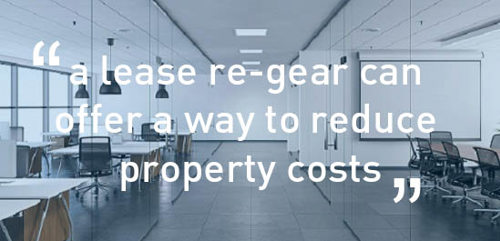
OccupiersOutlook: How to unlock value from your lease
Contacts
For more information please contact:
Once the lease has been signed, the rent free period has ended and there are several years left until the next break option or lease expiry; occupiers may (quite understandably) turn their attention to running their business and do nothing with their lease. This could be a missed opportunity.
Whether business is static or going through change, if an occupier intends to stay in their current premises, a lease re-gear can offer a way to: reduce property costs, remove a lease event which isn’t required, or eliminate onerous lease terms which impact on flexibility.
What is a lease re-gear?
A lease re-gear is the process of renegotiating or restructuring the terms of the existing lease during the course of the term. The key to unlocking the deal is to identify a mutually beneficial outcome for both the landlord and tenant.

When? Reactive or Proactive?
For some occupiers, approaching the landlord to renegotiate lease terms is a reactive response to an unforeseen change in business circumstances. The business may have outgrown its space or conversely it may need to shrink within or out of its space entirely.
For others, the trigger could be entirely proactive; in this situation the occupier has a better chance of securing an advantageous result. A proactive renegotiation can take place at any time during the lease term, but will usually be triggered at least 18 months before a break option or lease end date arises.
Why?
A re-gear can offer a number of advantages to an occupier, for example:
- Rent free/capital incentive.
- Reduced rent (if market rents have fallen).
- Increase or decrease square footage/space occupied.
- Potential to agree and/or cap dilapidations.
- Renegotiate and improve onerous lease terms.
Advantages for landlords include:
- Increased length of unexpired term giving greater security of income.
- Potential Increase in asset value.

Risks vs Benefits
Restructuring a lease which is on unfavourable terms can be highly advantageous for a business, however there is a cost. These costs need to be carefully weighed up against any flexibility being lost.
The key points to consider are:
- Both parties need to be willing and there must be upside in it for both.
- Removing a break option or extending the lease term restricts an occupier’s flexibility in exchange for financial benefits.
- Understanding the landlord’s investment position is paramount to achieving the best outcome.
- The opportunity is there to be taken, however occupiers must act early to avoid missing out.
To discuss your real estate strategy please contact GL Hearn’s Occupier Advisory Team.
- Share
Contacts
For more information please contact:
You may also be interested in



